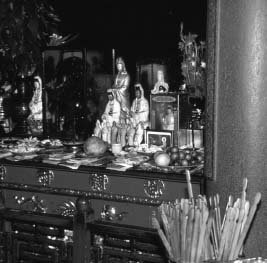Daoism and CctSigns and Symbols |
What are trigrams and hexagrams? |
Trigrams are sets of three vertically stacked horizontal lines made up of every possible combination of broken (— —) and solid (———) line. Solid lines stand for the solar male Yang, high, bright, active, and dry. Broken lines stand for the earthy and lunar female Yin, which is dark, moist, mysterious, and associated with valleys. Combinations of Yin and Yang in varying proportions give rise to the eight essential elements in creation. Traditional presentations usually arrange the eight trigrams as an octagon at whose center stands the tai ji symbol for perfect Yin-Yang harmony. Each trigram is arrayed so as to face its opposite in the set. So for example, if you held a compass before you with north pointing up, Heaven’s three solid lines would stand across from Earth’s three broken lines at what would be north and south. At due east stands Water, with a solid line between a pair of broken lines, across from Fire, with its broken line sandwiched between solids in the west. At northwest, Lake’s broken-solid-solid (reading from top to bottom) stands across from Mountain’s solid-broken-broken. And in the northeast, Wind’s solid-solid-broken balances off Thunder’s broken-broken-solid.
Take the eight trigrams and arrange them in all possible permutations by stacking one trigram atop another and you get sixty-four hexagrams. Pile Heaven upon Heaven and the result is called the “creative principle.” Add Earth to Earth and you get the “passive principle.” Earth over Heaven yields “peace,” while Heaven over Earth means “stagnation.” The single most important source for interpreting these arcane indicators is the Yi Jing, The Classic of Change. Tossing and rearranging a set of fifty sticks and then reading them as hexagrams with the help of that text remains a widely popular form of divination.

Images of Guan Yin and a barrel of joss sticks used for divination rituals in a CCT temple in Keelung, Taiwan.
